
views
Cleaning Your Oven Naturally with Baking Soda and Vinegar
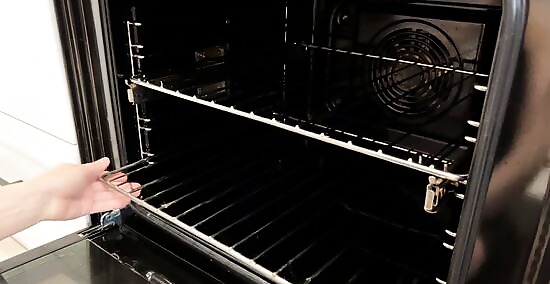
Remove the racks and other oven accessories. Make sure your oven is turned off and cooled down completely before you start. Pull out the oven racks and any other cookware you keep inside your oven. That way, it’s easier to reach and clean the bottom, sides, and back of the oven.
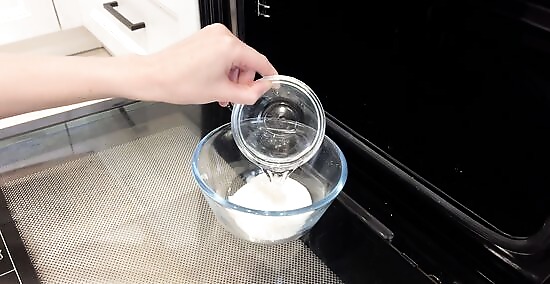
Make a paste of baking soda and water. Mix together ½ cup (114 g) of baking soda and about 3 tablespoons (44 ml) of water in a small bowl. Work the ingredients together until they form a thin paste. If your gas oven is really dirty, add a few drops of dish soap to the baking soda paste for added cleaning power. If the paste is too runny, add some more baking soda. If it’s too thick to spread, then add a little bit more water. Baking soda is one of the best gas oven cleaners because it’s natural, but it’s abrasive enough to scrub out residue without damaging your oven.
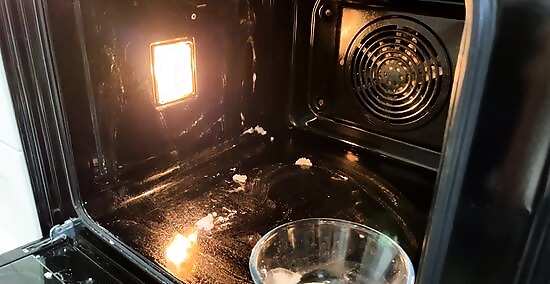
Apply the paste inside your oven using a dishcloth. Dip the corner of a dishcloth into the baking soda paste and start scrubbing inside your oven. Apply a thin layer of paste to the top, bottom, and sides of your oven. Don’t forget to apply the paste to the oven door and glass. If there are any areas that are really dirty, scrub it in with a little extra elbow grease. Avoid applying the paste near your oven’s pilot light so it doesn’t go out. Relight the pilot light right away if it accidentally goes out.
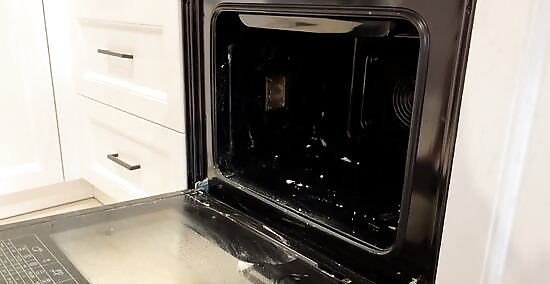
Let the paste sit in your oven overnight. As the baking soda sits, it will help loosen up all the food and grease stuck inside your oven. Give the paste at least 12 hours to work and come back to finish cleaning the next morning. Let other people in your household know that you’re cleaning the oven, and put up a sign as a reminder for them not to use it. While the cleaner is sitting in your oven, take advantage of the time to clean your oven racks.
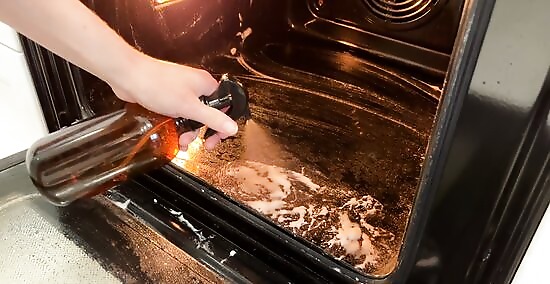
Spray the inside of your oven with vinegar. Pour some white distilled vinegar into a spray bottle. Coat the sides and bottom of your oven with the vinegar. The baking soda paste will start fizzing and add some extra cleaning power. If you don’t have vinegar at home, you can substitute it with lemon juice instead. Avoid spraying the vinegar right when you apply the baking soda paste because the ingredients will neutralize and won’t work as effective cleaners.
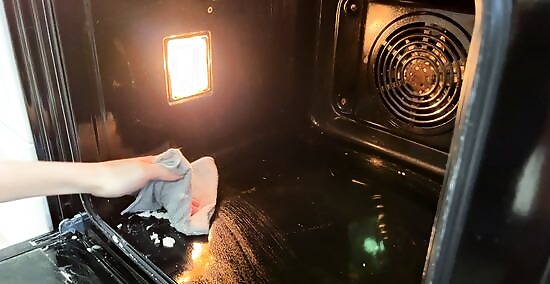
Wipe out your oven with a damp dishcloth. Wet a dish cloth and wring out the excess water. Then, wipe from the top to the bottom of the oven to remove the paste and food residue. As your cloth gets dirty, rinse it and wring it out again. Just keep wiping out your oven until you get rid of all the cleaner. If there’s any food or grease caked on your oven door, then remove it with a plastic scraper. Susan Stocker, a green cleaning expert, says that a pumice stone works great for cleaning the bottom of a gas oven. However, she says to be careful if your oven has a color interior because a stone could scratch the finish.
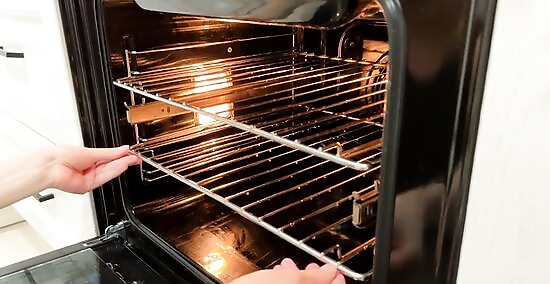
Put back any accessories you removed. Once you’re done cleaning, slide the racks back into your oven along with any other drip pans or accessories that you had inside. Then you’re ready to start cooking with your oven again.
Using the Self-Clean Function
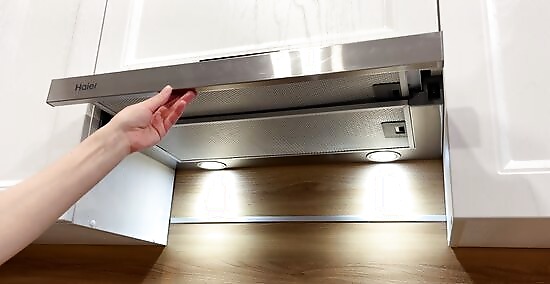
Open windows or turn on a vent fan. Running an oven’s self-clean function can create fumes, smoke, or bad odors, so always be sure to ventilate your space. Crack open a few windows or turn on the vent fan above your stove so the fumes and odors don’t get trapped inside your home. The self-clean cycle can also make your home get uncomfortably warm, so venting out the hot air will help keep the room at a comfortable temperature. If you have respiratory issues, using the self-clean function could irritate your lungs. Stick with using a different cleaning method instead. Turning on fans and pointing them out the window can also help vent out smoke and odors.

Remove any racks and oven accessories. Make sure your oven is turned off and cooled down before taking out the racks. The high heat of a cleaning cycle could damage your oven racks or accessories, so take them out to clean separately. However, some racks that have protective coatings can stay in your oven during the cleaning cycle. Check your oven’s manual to see what they recommend.

Wipe up large spills with soapy water. If there are large, noticeable spots or bits of food on the bottom of your oven, wet a dishcloth in soapy water. Wipe out as much as you can before you use the clean cycle so there’s less to clean up later. The self-clean cycle uses high heat to burn away food and grease, and large pieces of food could create a lot of smoke or foul odors.
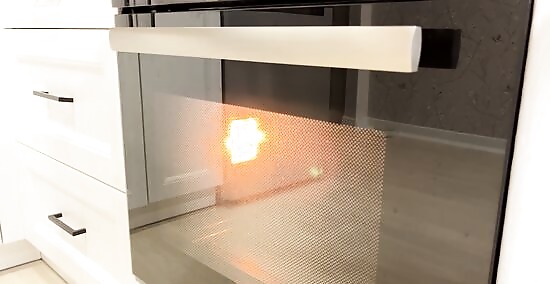
Set your oven to the self-clean cycle. Some ovens have a “Clean” button while others have a dial you turn to the Clean setting. Turn the oven on and lock the oven door so no one opens it up mid-cycle. For the next few hours, your oven will heat up and burn all the residue inside. Self-cleaning usually takes around 3–5 hours. During that time, never leave your oven unattended. Since the cleaning cycle can create smoke and foul odors, make sure to crack open your windows and turn on vent fans throughout the entire cycle. Avoid using the self-clean feature along with other commercial oven cleaners because it could damage the interior parts of your oven.
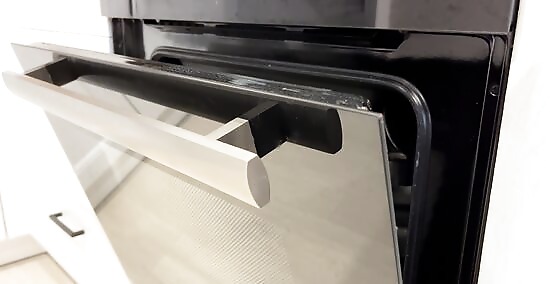
Let the oven cool completely. After the cleaning cycle finishes, give your oven another hour or two to completely cool down. Once it finishes, it’s safe to unlock the oven door and continue cleaning. Keep your windows open and fans running as your oven cools down so your home continues to air out.

Wipe out any leftover residue with a damp cloth. Wet a dishcloth and wipe out the ashes left inside of your oven. Work from the top of the oven to the bottom, and rinse out the rag as soon as it gets dirty. If you still see some residue stuck inside of your oven door, try using a plastic scraper to remove it.
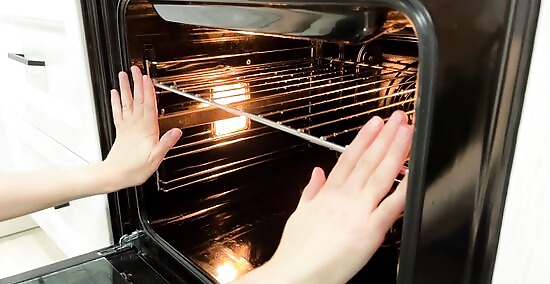
Replace any accessories you removed. Put the racks and anything else you took out back into your oven once you’re finished cleaning. After that, you’re ready to use your gas oven again. If you’re still noticing some lingering odors after you clean your oven, fill a baking dish with water and either lemon juice, white vinegar, or vanilla. Put the tray in your oven on low for an hour and the smell will disappear.
Using Commercial Oven Cleaners

Use a fume-free oven cleaner made for gas stoves. Most oven cleaners are safe to use in a gas oven, but some oven manufacturers recommend specific products or cleaning methods. If you have your oven’s manual, check the cleaning instructions and choose a product certified for your oven. Some of the best oven cleaners trusted by professionals are Easy-Off, Goo-Gone, or Method. Green cleaning expert Susan Stocker recommends using a degreaser like Krud Kutter.
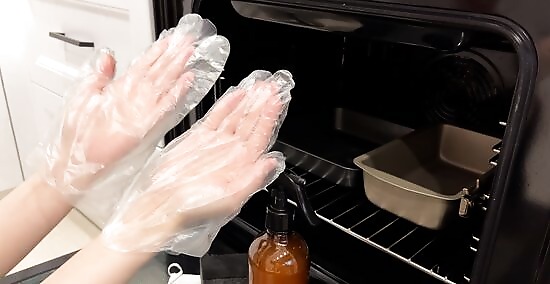
Put on a mask, safety glasses, and rubber gloves before starting. Since commercial oven cleaners contain chemicals, protect yourself with a mask that covers your mouth and nose. Put on some safety glasses and gloves for additional protection.

Take out any oven racks or accessories. Wait until your oven is completely cool if you recently cooked with it. Pull out any racks or cookware that you store inside of your oven so it’s easier for you to reach inside and clean. Set the racks aside so you can clean them separately.

Spray the inside of your oven with the oven cleaner. Coat all of the surfaces inside your oven with a thin layer of the cleaner, and let it sit for the recommended time listed on the package. Avoid spraying the cleaner on the area of your oven with the pilot light since you could extinguish it. Commercial products will usually clean your gas oven more quickly than other cleaning methods, but can contain harsher chemicals. Let other people you live with know that you’re cleaning the oven so they don’t turn it on.
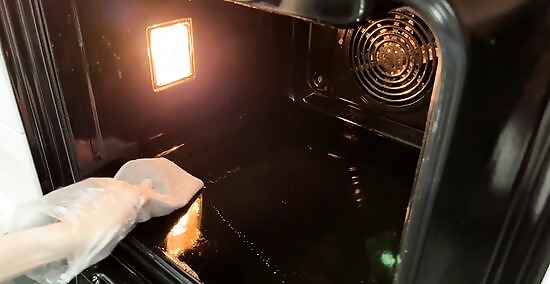
Wipe out your oven with a damp sponge or paper towel. Make sure your oven is completely turned off and cooled down before you start cleaning. Wet a sponge or paper towel with water, and wipe out all of the cleaner. Focus on scrubbing any areas that have stubborn food residue to lift up as much as possible. Try using a plastic scraper or apply more cleaner to food and grease stains that don’t lift up after the first pass. If there’s burnt residue on the glass on your oven door, green cleaning expert Susan Stocker recommends scraping it off with razor blade.
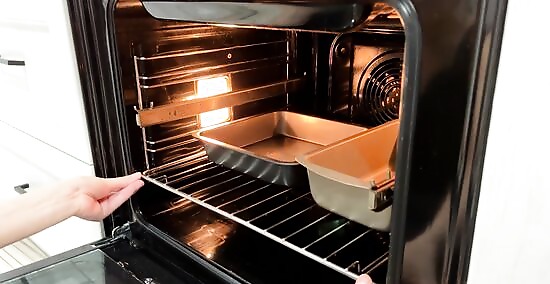
Put the racks and accessories back in your oven. Once you finish cleaning, slide the oven racks back into place and put back any cookware you were storing inside.
Cleaning the Racks and Exterior
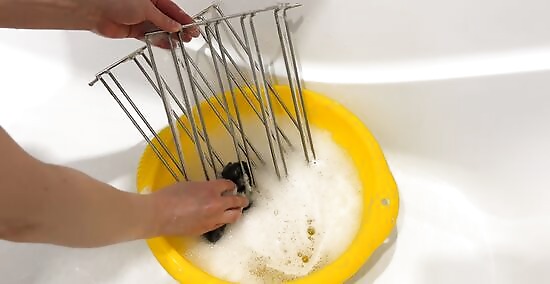
Soak and scrub your oven racks with soapy water. Put your oven racks in a sink, bathtub, or large tote bin filled with warm water and some dish soap. Let the racks soak for at least 2 hours or leave them overnight to remove tough grime and grease. Then, use a dishcloth or a stiff-bristled brush to scrub the racks clean. If you use your tub, lay towels down first so the racks don’t scratch the tub’s surface.
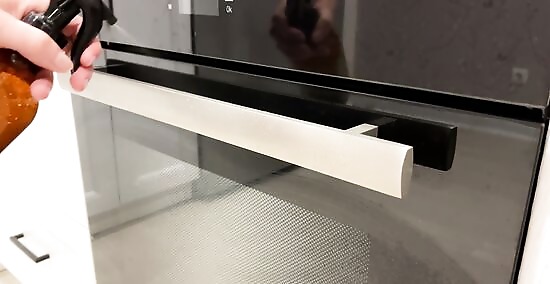
Soak oven knobs in vinegar. Most knobs easily pull off of your oven, so remove them and place them in a bowl of distilled white vinegar for about 5 minutes. After that, use a sponge or dishcloth to wipe any grease or residue off the knobs. Then, rinse them with soap and water before letting them air dry. Be sure to wipe the area underneath your oven knobs after you remove them since some grease and grime can build up. If you aren’t able to remove the knobs, then spray them directly with vinegar and wipe them up after a few minutes.
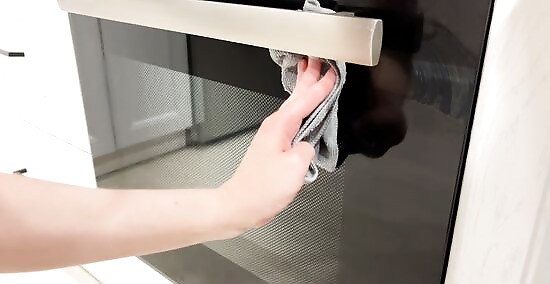
Wipe the outside of your oven with a damp cleaning cloth. Check the outside of the door and around the exterior for food residue, and use a wet cloth to wipe up any marks you see. If there’s any stubborn grime, add a few drops of dish soap to the rag and gently scrub the surface to remove it.
How often should you clean a gas oven?

Deep-clean your oven once a month. Rather than waiting for your oven to visibly get dirty, make it part of your monthly routine to clean your gas oven with vinegar or cleaners. That way, grime and grease won’t get caked on the sides and it’ll be easier to maintain. Regularly cleaning your oven helps your oven work more efficiently and will make your food taste better.

Wipe your oven after each time you use it. After you finish cooking and your oven cools down, take a damp rag and wipe up any food residue or marks you see inside. Since you’ll be cleaning a little bit every time you cook, grease and other food won’t have a chance to build up.
How can you tell if it’s time to clean your gas oven?
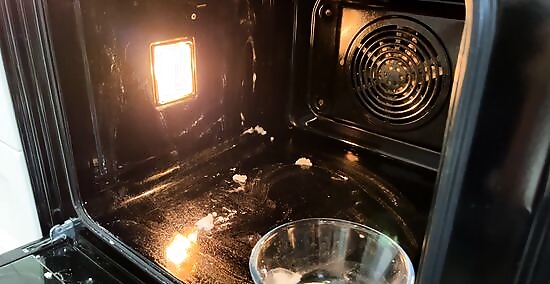
If your oven is dirty, it's time to clean it. If you can’t remember when you last cleaned your oven, then now is a good time! Some other common signs that your oven is due for a cleaning include: Food or grease on the bottom of your oven Longer preheating times Smoke or foul odors while you’re cooking Bad-tasting food
Maintaining a Gas Oven

Cover cooking pans with foil or a lid. To prevent accidental splatters and messes, put an oven-safe lid over your food or simply use a layer of aluminum foil. Covering your food can also help it cook more quickly to a consistent temperature. Rather than cooking food directly on the oven rack, use a baking sheet or cooking stone to prevent messes from spreading. Some recipes tell you not to use a lid to help your food get crispier. If that’s the case, consider removing the lid or foil during the last few minutes of cooking so the food still crisps on the surface.
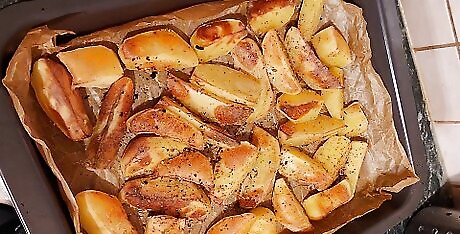
Fill cooking pans with less food. Foods like casseroles and pies can bubble and spill onto the bottom of your oven when the pans are too small. Either use a bigger pan, or split your food between multiple pans so there’s less risk of making a mess.

Place a baking sheet underneath pans when you’re cooking. Place an oven rack directly below the one you’re cooking your food on. Place a large baking sheet or large piece of foil on the rack to catch any spills before they reach the bottom of your oven.
Benefits of a Clean Oven

Better-tasting food When your oven is dirty, the foul odors from burnt residue can get into the food you’re cooking, giving it an off flavor. Cooking with a clean oven ensures you get the most flavorful food.
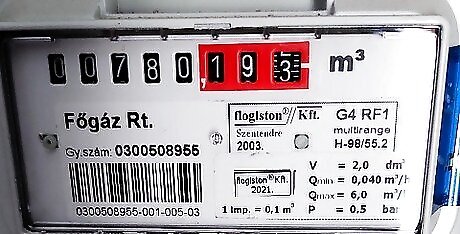
Lower energy bills When your oven is clean, it can distribute heat more evenly and become more efficient. When buildup starts to form, your oven may take more energy to heat up completely.



















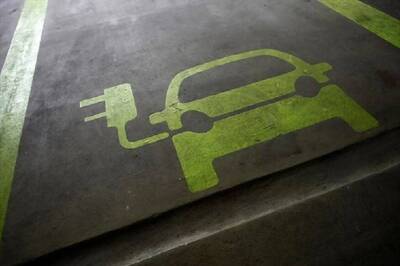
Comments
0 comment